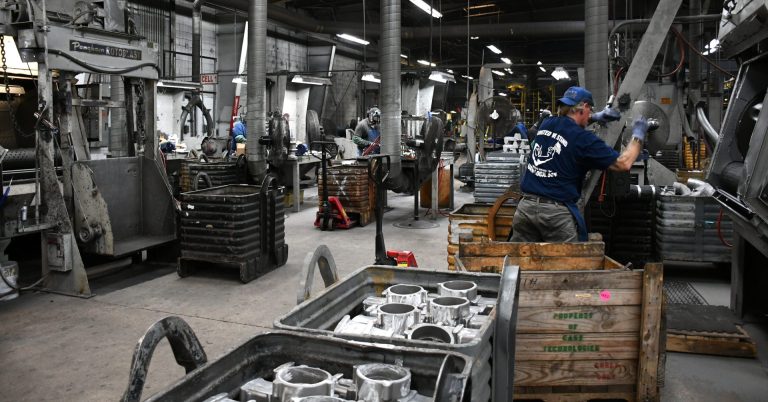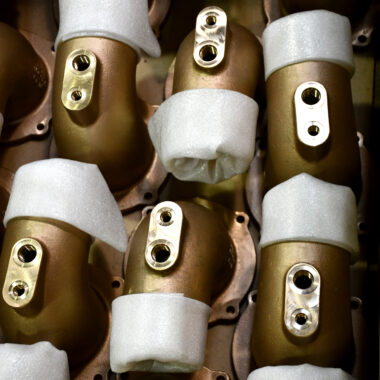Technology Released: Developments About Aluminum Casting
Wiki Article
Crafting Excellence: Just How to Achieve High-Quality Light Weight Aluminum Castings Every Single Time
In the world of aluminum casting, the pursuit of perfection is a continuous trip that needs a thorough technique and a keen understanding of the ins and outs included. Achieving regular high-quality aluminum spreadings demands an extensive grasp of the processes, from choosing the proper alloy to performing precise mold and mildew designs and diligently managing spreading parameters.Comprehending Aluminum Casting Procedures
Light weight aluminum casting processes, important in the manufacturing market, entail the detailed improvement of liquified light weight aluminum into solid forms through a collection of very carefully regulated actions. Comprehending these procedures is vital to achieving premium aluminum spreadings continually - about aluminum casting. The key techniques made use of in aluminum casting are die spreading, sand casting, and financial investment casting
Each of these processes has its advantages and is selected based upon factors like complexity, quantity, and preferred finish of the aluminum spreading. about aluminum casting. Understanding the intricacies of these approaches is important for suppliers intending to generate high-quality aluminum castings regularly
Selecting the Right Aluminum Alloy
Selecting the proper aluminum alloy is a vital decision in the manufacturing of high-quality aluminum spreadings. When choosing an aluminum alloy for casting, it is crucial to think about the particular demands of the application to make certain ideal efficiency.One of the most typically used aluminum alloys for casting is A356 - about aluminum casting. For applications needing high toughness, 7075 aluminum alloy is a popular option due to its outstanding strength-to-weight ratio.
In addition to mechanical properties, factors to consider such as cost, accessibility, and post-casting processes need to additionally affect the selection of the appropriate light weight aluminum alloy. By carefully evaluating these elements, suppliers can guarantee the production of top notch light weight aluminum castings that meet the wanted specifications.
Executing Appropriate Mold And Mildew Layout
Creating an effective mold and mildew layout is vital for important source ensuring the successful manufacturing of high-grade light weight aluminum castings. Correct mold design plays a substantial duty in achieving the desired qualities of the end product. To execute an effective mold and mildew style, elements such as product circulation, cooling prices, and component geometry must be very carefully thought about.One key facet of mold layout is making sure proper dental filling and solidification of the light weight aluminum within the mold and mildew dental caries. This includes making jogger and gating systems that facilitate smooth metal flow and prevent defects such as air entrapment or insufficient filling. In addition, including air conditioning networks into the mold and mildew design helps manage solidification prices and decrease the threat of porosity or shrinking defects.

Controlling Spreading Parameters

Guaranteeing Post-Casting Quality Checks
To preserve the high quality of light weight aluminum spreadings, detailed post-casting high quality checks are vital. After the spreading procedure is finished, it is vital to make sure that the last products satisfy the preferred requirements and specs.Dimensional precision is an additional vital element that needs to be verified throughout visit their website post-casting top quality checks. Dimensions of key dimensions and resistances ought to be required to confirm that the spreadings satisfy the called for specs. Additionally, mechanical buildings such as firmness, tensile stamina, and effect resistance may need to be assessed via material testing to ensure that the castings have the necessary stamina and toughness for their intended application.
Final Thought
To conclude, attaining top quality light weight aluminum spreadings calls for a thorough understanding of the spreading procedures, choosing the suitable alloy, designing molds imp source successfully, controlling spreading parameters thoroughly, and carrying out post-casting quality checks vigilantly. By adhering to these actions, manufacturers can continually generate light weight aluminum spreadings that meet the greatest requirements of top quality and performance.Attaining constant high-grade light weight aluminum spreadings demands a comprehensive understanding of the processes, from picking the ideal alloy to executing exact mold and mildew designs and thoroughly regulating spreading parameters. The main techniques made use of in light weight aluminum spreading are die spreading, sand casting, and financial investment casting.
Financial investment spreading, also understood as precision spreading, involves creating wax patterns that are coated in ceramic to develop mold and mildews.Choosing the suitable aluminum alloy is an essential choice in the production of high-quality aluminum spreadings.Making sure exact control over casting parameters is important for keeping consistency and high quality in light weight aluminum casting manufacturing.
Report this wiki page